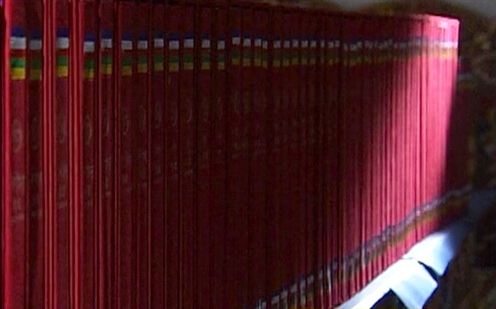Daniel Malinowski Stuart. "Thinking About Cessation": The Pṛṣṭhapālasūtra of the Dīrghāgama in Context. Wiener Studien zur Tibetologie und Buddhismuskunde 79. 112 pp. ISBN-13: 978-3-902501-17-2.
Saddharmarāja V., Nāmamantrārthāvalokinī (2011)
Paṇḍita Kavirāja Saddharmarāja Bajrācārya Śāstrī (tr.) Ārya Mañjuśrī Nāmasaṅgīti: advayaparamārtha nāmasaṅgīti. Ācārya Vilāsavajra kṛta Nāmamantrārthaavalokinī Ārya Mañjuśrī Nāmasaṅgītiyāgu ṭīkāyā lidhaṃsāy, ṭippaṇī va bhāvārthasahita Nepālabhāṣāy saṅkṣipta anuvāda. Lalitapura: Rāmeśa Maharjana saparivāra, VS 2068 [2011 CE]. na+320 pp.
Facsimile Edition of All Palmleaf MSS in the TAR (2012?)
བོད་རང་སྐྱོང་ལྗོངས་སུ་ཉར་ཚགས་བྱས་པའི་ཏ་ལའི་ལོ་མའི་དཔེ་ཆ་ཀུན་བཏུས་པར་མ།
《西藏自治区珍藏贝叶经影印大全》(共61分册)
*Facsimile Edition of Palmleaf Manuscripts in the Tibet Autonomous Region: Complete Collection. 2012(?). 61 vols.བོད་རང་སྐྱོང་ལྗོངས་སུ་ཉར་ཚགས་བྱས་པའི་ཏ་ལའི་ལོ་མའི་དཔེ་ཆ་ཀུན་བཏུས་ཀྱི་དཀར་ཆག་བསྡུས་པ།
《西藏自治区珍藏贝叶经影印大全简目》
*Facsimile Edition of Palmleaf Manuscripts in the Tibet Autonomous Region: Complete Collection. Brief Index. 2012(?).བོད་རང་སྐྱོང་ལྗོངས་སུ་ཉར་ཚགས་བྱས་པའི་ཏ་ལའི་ལོ་མའི་དཔེ་ཆ་བྲིས་མའི་རྩ་བའི་དཀར་ཆག།
《西藏自治区珍藏贝叶经总目录》(共4册)
*Master Catalogue of Palmleaf Manuscripts in the Tibet Autonomous Region. 2012(?). 4 vols.

Continue reading “Facsimile Edition of All Palmleaf MSS in the TAR (2012?)”
Park, Korean-Chinese-Sanskrit-English dictionary (2012)
박 종매 (Pak Chong-mae). 현대 한·영 불교용어사전 (Hyeon-dae Han-yeong Bul-gyo yong-eo sa-jeon). 푸른 향기. 2012-05-19. 28,000원 [official announcement]
Jongmae Kenneth Park. Modern Korean-Chinese-Sanskrit-English Buddhist dictionary. Seoul: Prunbook Publishing, 2012. 642 pp. ISBN 9788992073929.
The Sanskrit terms are typeset without diacritics, unfortunately. A scholarly Buddhist dictionary of Korean and Sanskrit is yet to be produced.
Sonam Tsemo (Xu tr.), Intro to Buddhist Tantra (2012)
薩迦二祖索南孜莫(作者), 許明銀(譯者) 《印度西藏密教概論:認識最初之體系性密教概說》 大千出版社 2012年12月22日
Sa skya Bsod rnams rtse mo [b.1142], Xu Ming Yin [b. 1952] (tr.). Yindu Xizang mi jiao gai lun: ren shi zui chu zhi ti xi xing mi jiao gai shuo [*Introduction to Indo-Tibetan Tantric Buddhism: Understanding the first systematic primer on tantra(?)]. Taipei: Darchen, 2012. ISBN: 9789574472673 [books.com.tw]
A partial Chinese translation of the earliest rGyud sde spyi’i rnam par gzhag pa. See Xu’s unofficial introduction.
KL Dhammajoti, Reading Buddhist Sanskrit Texts (2012)
Kuala Lumpur Dhammajoti. Reading Buddhist Sanskrit Texts. An Elementary Grammatical Guide. Hong Kong: Buddha-dharma Centre of Hong Kong, 2012. ix + 361 pp. ISBN 978-988-16820-1-7 [available from Swindon Books]
A book that finds and almost fills its niche. Some weirdness is apparent, like the fact that sentences in romanized transcription do not appropriately add white space after finals. There are numerous typos and mistakes in sandhi, and there are no keys to the exercises — always a severe limitation. However, a patient and competent reviewer could easily detect, report and fix most of these problems. Any effort to knock down the high walls erected around the study of Sanskrit in ‘the West’ is, of course, worth encouraging.
From the Preface
“There are many excellent Sanskrit primers […] However, they all share the common feature of being based on non-Buddhist sources […]
many Buddhist students […] need to spend a large amount of time getting acquainted with those texts which are neither their concern proper nor source nor inspiration […]. It is out of this consideration that […] I had been thinking of producing an elementary manual totally based on the Buddhist texts” (p. v).
Tachikawa, Essays in Buddhist Theology (2012)
Tachikawa, Musashi. Essays in Buddhist Theology. Delhi: Motilal Banarsidass, November 2012. ISBN-13: 978-8120835405. INR 500. [official]
A translation of Budda no tetsugaku (1998) [corrected].
Cover note
“Buddhism does not recognize a concept of the existence of God (theos) such as found in Christianity, but here theos is not used to refer only to an absolute deity like the Christian god. By “theology,” the author means the systematic delineation of the confrontation with the condition of the times while carrying on the engagement between the divine and oneself.
Continue reading “Tachikawa, Essays in Buddhist Theology (2012)”
Helliwell, Layard & Sachs, World Happiness Report (2012)
“The happiest countries in the world are all in Northern Europe…”
John Helliwell, Richard Layard and Jeffrey Sachs (eds). World Happiness Report. The Earth Institute, Columbia University, April 2 2012. [official / PDF]
So much to comment on, so little time. For starters: if you are a Theravādin, social capital and personal wellbeing have nothing to do with each other. Suffice it to say that much of the reaction has been unhappy. Related studies (e.g., on how ‘happiness’ has been quantified) may be found at the authors’ homepages.
Suzuki, ‘Why did Korea become Christian?’ (2012)
鈴木 崇巨 (著)『韓国はなぜキリスト教国になったか』 春秋社 2012
Suzuki, Takahiro. Kankoku wa naze kirisutokyōkoku ni nattaka (*Why did Korea become a Christian country?). Tokyo: Shunjūsha, 2012. 217 pp. ISBN: 9784393222065. [official]

Simha, Tantrākhyāna (2009)
Tulasīlāla Siṃha. Tantrākhyāna: Ne saṃ. 638 yā mūlapāṭhayā sampādana, anuvāda va vivecanā. Yala: Nepālabhāṣā Kendrīya Vibhāga, Pāṭana Saṃyukta Kyāmpasa, 2009.
This is a transcription and translation into contemporary Newar of the earliest dated manuscript of the Tantrākhyāna(kathā) kept in Nepal. An older manuscript of this Newar Buddhist Pañcatantra remake — if we could call it that — ended up in the hands of Cecil Bendall and is kept in the United Kingdom, presumably unavailable to Mr. Siṃha.

